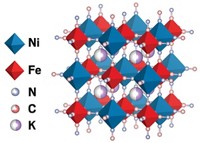Advertisement
Grab your lab coat. Let's get started
Welcome!
Welcome!
Create an account below to get 6 C&EN articles per month, receive newsletters and more - all free.
It seems this is your first time logging in online. Please enter the following information to continue.
As an ACS member you automatically get access to this site. All we need is few more details to create your reading experience.
Not you? Sign in with a different account.
Not you? Sign in with a different account.
ERROR 1
ERROR 1
ERROR 2
ERROR 2
ERROR 2
ERROR 2
ERROR 2
Password and Confirm password must match.
If you have an ACS member number, please enter it here so we can link this account to your membership. (optional)
ERROR 2
ACS values your privacy. By submitting your information, you are gaining access to C&EN and subscribing to our weekly newsletter. We use the information you provide to make your reading experience better, and we will never sell your data to third party members.
Environment
Removing Nitrogen From Wastewater Would Clean Air, Too
Climate Change: By adding a treatment step, plants handling wastewater could cut N2O emissions
by Lucas Laursen
August 17, 2011

Before discharging water into rivers and the sea, wastewater treatment plants chemically modify the dissolved nitrogen-based nutrients to limit the water’s environmental impact. Researchers now report that cutting the amount of reactive nitrogen in wastewater, would clean the atmosphere by trimming emissions of nitrous oxide (N2O), a powerful greenhouse gas (Environ. Sci. Technol., DOI: 10.1021/es200419h). This extra treatment step could partially pay for itself by cutting a plant’s energy use and by providing revenue from emissions trading markets, the researchers say.
Wastewater treatment plants limit the release of the most environmentally damaging forms of nitrogen using microbes that convert the chemicals into less harmful forms, such as nitrates. Since this procedure doesn’t remove the nitrogen from the water, bacteria in the environment can consume the nitrogen and produce N2O. The Intergovernmental Panel on Climate Change estimates that, compared to carbon dioxide, N2O has a long-term greenhouse warming effect 300 times greater.
A water treatment step called denitrification can remove wastewater’s N2O-forming potential by using different bacteria to convert nitrates into chemically inert N2 gas. However, most plants haven’t implemented the process because few states require it and because it involves building infrastructure.
James Wang, now at the National Oceanographic and Atmospheric Administration, and his colleagues wanted to estimate potential reductions in N2O emissions from denitrification and the costs to treatment plants of implementing the process. They used an Environmental Protection Agency model of N2O emissions that calculates the amount of gas released based on how much nitrogen flows in and out of a wastewater treatment plant. Using data from previous studies of nitrogen flows in U.S. plants and estimates of how denitrification would change those data, the researchers calculated that the treatment step could cut N2O emissions nationwide by as much as 48,000 metric tons per year, which is 37% of the teams’ maximum estimate of U.S. plants’ annual N2O emissions.
Wang and his colleagues next wondered how much revenue wastewater treatment plants could generate if they participated in emissions trading markets. In these proposed markets, a plant that reduces greenhouse gas emissions can sell carbon credits to companies that release CO2 equivalents above an established limit. The researchers considered multiple levels of N2O cuts and envisioned various market values for CO2 equivalents. They found that revenue from the cuts in N2O emissions could offset the operating and maintenance costs of denitrification facilities by between 0.2 and 68%.
Denitrification also could shrink plants’ energy bills. The bacteria that reduce nitrates also perform two treatment steps that a plant must complete before discharging the water: oxidizing organic matter and increasing the water’s alkalinity. Based on plant designs and electricity prices in the U.S., the team calculated that the energy savings from removing those two steps could offset between 1 and 11% of a denitrification facility’s costs.
But whether a denitrification upgrade is worth it to a plant will depend on the local regulatory environment and on the plant’s finances, says Lauren Fillmore, a project manager at the Water Environment Research Foundation, a non-profit organization in Alexandria, Va. Fillmore, who worked with some of the researchers on a related project, adds that models that address such local variables could provide plant operators with better estimates of the feasibility of an upgrade.





Join the conversation
Contact the reporter
Submit a Letter to the Editor for publication
Engage with us on Twitter